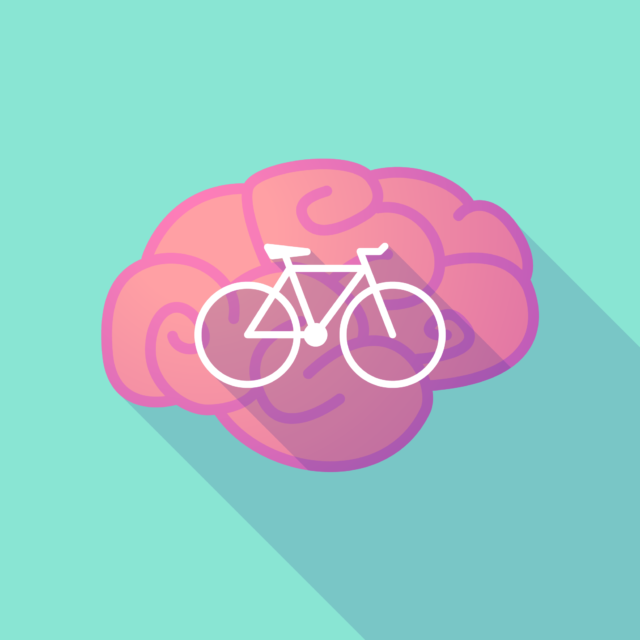Reading time: ~5 minutes (or less time than it takes to find your keys)
Summary: Walking or biking to your job might actually make you better at it.
Imagine in less than an hour you have a huge meeting, or exam or, if you’re particularly troubled, a stand-up comedy set. The venue is 20 minutes away.
This thing is huge, so, of course, you want to be on top of your game. You want to be quick and responsive, maybe even witty.
Is there actually something you can do increase mental performance and mood on the way to the gig?
That’s what a group of Stanford researchers set out to answer in 2013.
Spoiler: you can. And all you need is a bike…
The Stanford scientists invited about 150 people to Palo Alto. When everyone arrived, they were tested on their mood. Then they took a challenging cognitive exam. Afterwards, the researchers split them into random groups. The first half (the “Bikers”), were instructed to peddle a stationary bike at medium intensity for 15 minutes. The second group (the “Mentalists”) were given a mildly difficult brain exercise to complete.
Following the each group’s exercises– the biking and the mental test– everyone took the same tests for mood and cognition. Their results were then compared to their pre-exercise scores.
So what do you think happened?
You’ve likely heard that exercise is ‘healthy.’ You may have even heard that it’s associated with useful things like not getting heart attacks or falling and breaking your hip. However, these things, though important, may not have been compelling enough to get you to the gym. Why?
The problem with those kinds of “scientific” benefits are (1) they take a long time and (2) they’re not direct cause and effect— exercise is usually sold as a mere association with less heart disease.
That’s precisely why Dr. Candice Hogan (now a behavioral researcher at Uber) and colleagues set out to test immediate, causal benefits of exercise. They wanted to see if something as simple as a mildly challenging bike session could result in smarter, better mooded people.
Their findings were impressive.
In just 15 minutes of biking at “moderate intensity”— which is basically how it feels when it becomes a little challenging to talk because you need to breathe in and out every few words—participants significantly improved performance on the exam compared with how they performed on the same test before the bike ride. The non-exercise group showed no change.
But what does “significantly” mean? How much better?
About 10%.
The exercisers—whether teens or elderly— completed the exercise, on average, 10% faster than they had just 15 minutes prior. Just by peddling a bike with mild effort.
But, is 10% really that impactful?
Let’s look at some examples.
10% Smarter For The Student
The average SAT score is 1060. 10% better would mean you get an 1166, over 100 point increase. A 100-point increase is basically the difference between admission to Harvard (#3) and Haverford (#39). Exercise before the test, and you’ll avoid having to constantly correct your parent’s friends. “Oh, Harvard, impressive! Uh, no, no… Haverford…”
If you’re shooting for a more ‘realistic’ University of Maryland (like I did), that 15 minutes on the bike is even more pronounced. You become a big-school Maryland Terp (#75) instead of a more obscure St. Mary’s College of Maryland Osprey (#172). (Not that there’s anything wrong with that).
Of course, if your parents are, say, rich actors with a penchant for Photoshop— exercise matters less…
10% Smarter For The Business Pro or The Artist
Michigan professor, Tom Connellan, has shown that the difference between top performers and middle-of-the-pack is deceivingly small. Often the difference is a couple percentage points.
For example, the best outdoor one-mile running time ever recorded is 3:43 (223 seconds). The 99th best? 3:50 (230 seconds) — a difference of 3%. The 427th best? 3:56 (236 seconds), also about 3%.
It takes a long time to get to a difference of 10%– thousands. 1400 people, for example, have broken the 4 minute mile— just 7.5% away from the world record.
An average college track athlete apparently runs a 4:25 mile, which is only about 18% worse than the world record. Even Malcolm Gladwell, a high-school middle-distance runner, now in his 50s, ran a sub-five-minute mile which is only 30% worse than the best time in the history of recorded humans.
All of a sudden, 10% seems pretty darn significant.
By merely walking briskly to that big meeting or nerve-raking comedy set, you’ll be, not just a couple of percentage points better, but a full 10% better than if you took an Uber (Dr. Hogan sorta shot herself in the foot there…).
10% clearer, sharper, more enthusiastic. According to Connellan, that’s more than enough to distinguish excellent from middling in most fields.
Here, of course, we are talking about a 10% better you.
The Bottom Line
To function at its best, your brain requires at least three things: 8ish hours of sleep, green veggies, and movement.
The key virtue of exercise is not that you feel better or that you lose weight, or even that you help prevent heart attacks— though, those are all nice perks. It’s that you enable your brain (and by extension, You) to be at its best. That applies to anything you are doing: business, parent, stand-up comedy.
Even moderate movement for a short-while gets your brain working better, both analytically and emotionally. Even better, this easy change in behavior— walking to the meeting or taking a bike ride to the exam— is low-maintenance and virtually zero risk.
The downside here is a little sweat (and probably a smaller waistline).
The upside?
You, only smarter.
Further Reading
But if exercise is so obvious a brain-boost, why is it that most people don’t even get the minimum daily requirement of exercise? I call that the Exercise Paradox. Here’s more.


